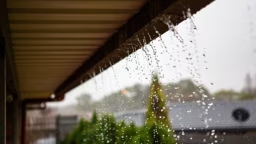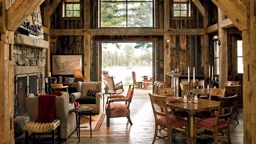An open, wood-burning fireplace is steeped in nostalgia. The ambiance that a massive hearth and roaring fire produces in a log or timber home takes us back to another, simpler era. But actually owning one of these beauties is not what it seems. I liken it to having a Model-T Ford. It was once the most popular form of transportation — cutting edge for its day. But cars have come a long way in terms of safety, fuel economy, functionality and upkeep. So while the Model-T is cool to own (if you have the discretionary funds) and may be fun to take for a spin every now and then, it’s not something you want to drive and maintain regularly.
Masonry wood-burning fireplaces are much the same — an antique — and a complicated, expensive one at that.
A true masonry fireplace consists of a cement block framework containing a firebox, a flue and a chimney (see the diagram on page 14) that exits from one point in the house, whether it’s through the roof on a gable end, the center of the roof at the ridgeline or on the side of the house. There’s a gap between the firebrick and concrete masonry blocks that comprise the chimney, a builder’s technique that keeps the heat from shattering the block itself.
When it comes to incorporating a masonry fireplace in a log or timber home, the biggest issue that has to be addressed is weight. These fireplaces are heavy, and you have to start at the foundation level to support their heft.
To start, you need to pour a thickened (16-inch) reinforced (rebar and a 4000psi concrete mix) slab to carry the load from the ground, through the floor system and all the way out of the roof with at least a 2-foot clearance from the ridgeline for fire prevention, as per code. These criteria are hugely important, because the last thing you want is for the fireplace to create pressure on the ground and eventually crack or worse — collapse.
From there, your mason will build up the block work from the foundation/basement through the subfloor. It’s critical that the places where the unit penetrates the floor(s) and again at the roof need to be sealed properly. In a log home, this can be a challenge due to settlement. During construction, your builder will need to incorporate a system that will allow the roofing material to slide along the fireplace, which will remain static, so that the roof can move with the log walls as they settle into place. As a result, the roof won’t be attached to the fireplace directly, so the builder will box around it and flash it so that rain will deflect and the home remains weather tight.
These parameters merely set the stage for the fireplace. Decisions must be made on size, design, number of openings (e.g., double-sided), facing materials, wood storage and a host of other factors that impact its construction and its price.
Without a doubt, a masonry fireplace is a luxury purchase, and, in all honesty, the return on investment is almost zero. Not only is it more costly to build, because of its inefficient nature (interior heat loss through the flue/chimney) it ultimately costs you more money to operate than other available fireplace options.
But as we said at the start, the feeling that a wood-burning fireplace evokes — not to mention its place in log and timber home lure — can’t be denied. If you’ve got the desire and the budget to integrate one into your home, be sure your team knows how to design and build it right.
Take Note! Bans on Burning
In wildfire-prone states, like California, or emissions conscious areas, like Colorado, building a new wood-burning fireplace is prohibited and there are environmental-condition restrictions on when you can fire up existing units. If a wood-burning fireplace is in your plans, make sure you can use it.
Is firebrick different from standard brick?
Yes. Firebrick is a dense composition of silica, alumina, titanium and ferric oxide, while standard brick consists of clay, shale and other materials fired into a durable ceramic product. While all bricks are more resistant to fire than other materials, firebrick can withstand temperatures up to 1,800 degrees Fahrenheit for extended periods of time, making it the safe choice for masonry fireplaces.
Pros & Cons of a Masonry Wood-Burning Fireplace
pro: Flexibility when it comes to size, including the dimensions of the firebox opening
con: Cost — A masonry fireplace will almost always cost more (often 3x more than prefabricated models) in materials, construction and foundation reinforcement
pro: Unlimited design and material options
con: Interior heat loss through the firebox/flue/chimney; not the most efficient heat source
pro: Nostalgic choice for log and timber homes (lodge look)
con: Chopping/buying, storing and fetching firewood
pro: The aroma and ambiance of a wood fire
con: Maintenance — Annual checks for creosote, regular chimney cleaning and ash removal after every fire burned
About the Author: Dan Mitchell is a builder and a Log & Timber Home University professor. He owns Eagle CDI, a construction firm based near Knoxville, Tennessee.












